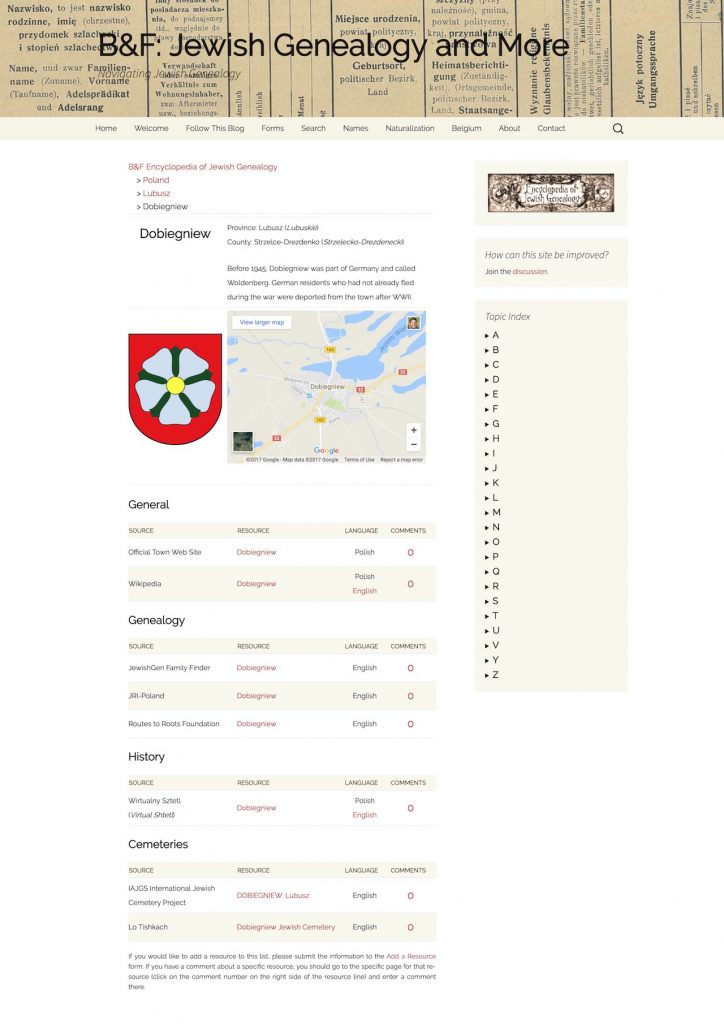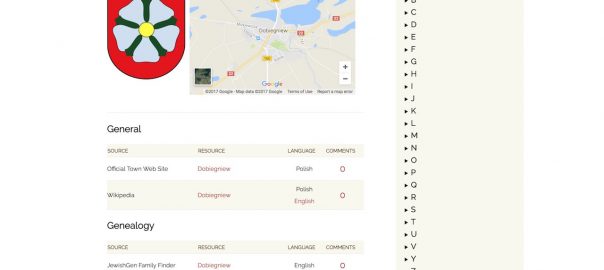I’m happy to announce that I have just added over 200 new Polish towns to the B&F Compendium of Jewish Genealogy. This brings the number of towns in the compendium to over 1200, and I think it is the largest database of Polish towns with former Jewish communities, or a connection to former Jewish communities, online. Many of these towns are towns that before 1945 were part of Germany (primarily Prussia), so while the compendium only (currently) lists towns within the borders of Poland, many people who had family in Germany may find their ancestral towns listed. I should point out if you search for the old German name of a town it should show up (i.e. if you search for the German town name Woldenberg, it will give you a link to the Polish town name Dobiegniew).
It’s been over a year since I launched the compendium with resources for roughly a thousand towns in Poland (in addition to resources on over 200 countries and 80 provinces). Time is a good thing, as it allowed me to forget how hard it was to add towns to the compendium. Once I got started, however, I needed to see it through to completion.

I’ve known since I launched that I did not have all the Polish towns where Jews lived, but I worked very hard to confirm the identity of each town I added, and that was painstaking work. When I add resources I spend a lot of time confirming that they are connected to the correct town, something that is not so easy when dozens of towns in Poland can have the exact same name. What that meant was complicated efforts to cross-reference all the resources between many sites, checking geographic coordinates if they existed for a resource, comparing alternate names for the town, and whenever possible checking the province and county of the town.
Checking the province and county proved especially difficult since many sites did not use the current province and counties if they had them listed at all. Poland has changed their regional designations many times in the last century, which means if you’re referencing old documents, then they could give the wrong information. Luckily, geographic coordinates don’t change, so for resources that included them, that allowed synchronization of resources. The end result is that all the towns in the compendium are firmly identified, and their current province and county are identified on their town page.
I wrote recently about adding new cemetery resources, including pages from Lo Tishkach, an organization that is collecting information on Jewish cemeteries in Europe. When I added the Lo Tishkach resources, I analyzed the pages that did not have towns in the compendium. I removed the towns that only had associated mass graves as they were probably not indicative of a Jewish community having existed there. Looking at just the towns that had a Jewish cemetery left me with over 200 towns that I did not have in the compendium.
Clearly, not all of these towns had Jewish communities either. Many Jewish cemeteries were built outside of the communities they served. While I’m sure a handful of the towns I’ve added only had a Jewish cemetery there, and not a living community, I’ve added them since the names of these towns still come up in research. Where I’m fairly certain that the town only had a cemetery, I’ve made note of that. Occasionally, if I only had a single cemetery reference to a town, and I was sure it was used by a different town with a Jewish community, I simply added that link to the town with the existing community.
It’s not surprising that sites like the IAJGS Jewish Cemetery Project and Kirkuty had many links to these towns, as they are similarly focused on cemeteries. Where I was pleasantly surprised, however, was when I started collecting resources from other sites to connect to these towns. Virtual Shtetl had over 150 of the towns in its database, JRI-Poland lists records for over 50 of the towns, and Routes to Roots had information on over 70 of the towns. I also discovered that while none of the towns existed in the JewishGen Communities database, many of the towns had listings in the JewishGen Family Finder (JGFF) database.
As a side note, I’ve changed how I link to the JGFF, so where before I only linked to JGFF if there were listings for the town, I now always link to it. If you have family from a town, and you see no links, add your family. I’ll be writing more about this in another post soon.
When I said above that I made note of some towns only having a Jewish cemetery, those notes actually show up on the page. I actually added notes about many of the towns when I added them last year, but never displayed the notes on the town pages. Many of these new towns came from the border areas that before WWII were part of Germany, and as I added notes to point this out, I made sure to turn on the notes on all the town pages. If the town has a note, you’ll see it displayed below the province/county information, and above the map.
It’s clear that there are more towns to add, and in time I hope to do so. In this batch I came up with about ten towns that I was able to identify but not easily cross reference due to not being able to find certain information on them. I will continue to look for the information I need to add those towns. I’m also always happy to receive suggestions for new towns to add, although I can’t promise to add them as I have many requirements I need to satisfy before adding them, but they will get added to my queue for future consideration.
So take a look at the expanded alphabetical List of Polish Cities, and check out the towns where your family lived. If you know of resources I’m missing, please submit them to be added. If you find resources you were previously unaware of, write a comment here and let me know how the site has helped you with your research.
